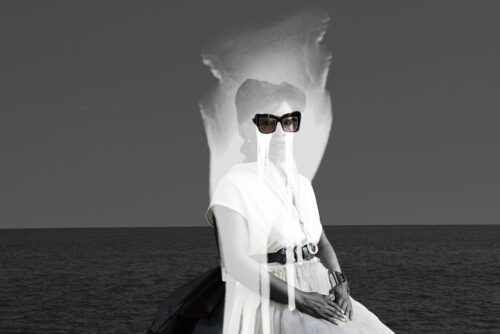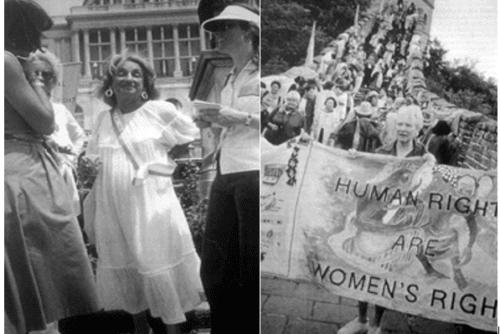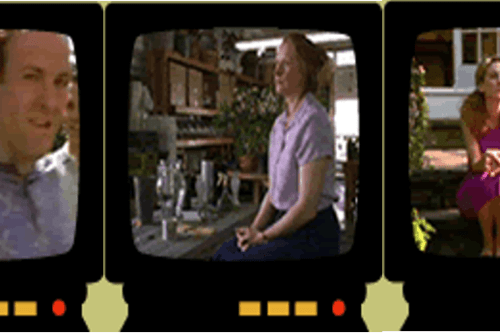This conversation was part of the Helen Pond McIntyre ’28 Lecture delivered by Dána-Ain Davis on her book Reproductive Injustice: Racism, Pregnancy, and Premature Birth (NYU Press, 2019) on October 19, 2022. The transcript has been edited for clarity.
Sarah Haley: I have the unfortunate responsibility of following that brilliant talk. It’s daunting to be in conversation with you as someone whose work is in Black feminism, and your work has been so influential. So, it’s really an honor to talk to you tonight and to be here.
I feel compelled by the ending of your talk to begin with a question about storytelling. You presented us with Yvette’s story and Krystal’s story, and it strikes me from both reading [the book] and hearing you read from the book that this is in deep conversation with theorists like Katherine McKittrick, who in her recent book Dear Science talked about storying as theory. So I was just wondering if you could tell us a little bit about how you approach the story? How you approach hearing and recounting and narrating and making choices about that? I’m particularly struck because McKittrick talks about the story as contesting biocentric accounts and practicing “Black livingness.” And this work is about Black livingness in doubt, right? Always in peril, always in doubt.
Dána-Ain Davis: Thank you. To be in intellectual space with Katherine McKittrick is an honor. Thank you for that. One of the things that I would say about her work is in her book Dear Science she uses the term “methodological disobedience,” but then in a talk that she gave with you and Ruthie Gilmore and a few others, I think I heard her say “disciplinary disobedience.” And that was not language that I had when I was writing. In retrospect, that is what I was doing.
But I do think that Black livingness comes really profoundly from storytelling. I think a lot of anthropologists, most of us, are storytellers. But, of course, we have this history of storytelling and creative storytelling in Black Studies really broadly. I’m thinking of the brilliant way…I don’t know what people’s feelings are about DuBois…but the brilliant way that W.E.B. DuBois wrote and produced “The Star of Ethiopia,” a pageant that was performed in 1913, ‘15, ‘16, and ‘25 with hundreds and hundreds of people to tell the story of Black life over centuries. We have storytellers and beautiful narratives in various forms by Zora Neale Hurston. We have storytelling and embodied performances by Katherine Dunham. So, we have a history in our discipline of storytelling and really creative ways to talk about Black livingness, about Black futurity, and about possibility. And then we have more contemporary people creating beautiful narratives. I think Aimee Cox is one of them. Savannah Shange is another. And what I like about the way Katherine McKittrick lays out Black livingness through creative storytelling is she also talks about citation. In our discipline, we have John Jackson who tells a whole other narrative in his footnotes—I mean, you’re basically reading two books.
I would say that the storytelling that I do comes from the family that I’m in, which was all about stories, but was deeply supported by my mentor…I don’t like to use the word mentor…by my friend, Leith Mullings. She supported not only storytelling of Black livingness but she supported her students being really creative about the ways in which we collected data. Back in the nineties, right after welfare reform had been passed by that President—I’m not naming his name—Leith was approached to develop a program called the Scholar Practitioner Program, and I was a beneficiary of that, along with six other people. So, we were seven women of color who were collecting data to examine the impact of welfare reform policy in two communities in New York City: Harlem and the Lower East Side, Chinatown in fact. And Leith had us develop our own strategies to do this. So, we did typical things like focus groups and surveys, but we also implemented what was then a fairly new methodological approach which was photovoice, oftenused in public health. We gave cameras to people in Harlem and on the Lower East Side to take pictures of what the impact of welfare reform had been. Then we brought people together and had them talk about what those images meant and then collectively they developed captions. And then we took all of these images and organized them in the form of an exhibit. We did exhibits in Harlem and the Lower East Side. The exhibit went to some meeting of the Congressional Black Caucus. What we heard was people talking about their lives. They were very deeply stressed about the loss of healthcare. We interviewed people and took pictures and created these one-page sheets that they, the people, could use when they went to Albany to protest about the outcomes of welfare policy. This was a three-year project and we were not the only team doing this. There were teams in New York, Florida, Mississippi, the state of Washington, Wisconsin, and I’m missing a state. We were working in communities and with community-based organizations. And I didn’t remember any of this until last Thursday when I had to write comments honoring Leith.
And I’m struck and I’m thinking, what is this method that she brought to us? We never had a conversation about methods. We had never had a conversation about stories. And in one brief moment, I was like, “Oh my god, what she supported us in doing was the manifestation of a Black radical tradition.” The possibilities of working with communities so that they could develop their own strategies for addressing the ways in which they were being oppressed through welfare, in particular. Then we did all these other interesting things, which was to take the kind of information that people said they needed in order to successfully move through the new welfare system. We did these palm cards in English, Spanish, and Mandarin so that people would be able to quickly identify how they could access resources in New York City.
So, all of that is to say that the support of methodological disobedience in order to honor Black livingness comes from many sources, but it’s really stunning when it comes from a person who you’re in class with, you know, who never used the term Marxist but had an idea that we were all supporting a revolution.
SH: That was so powerful. And it’s interesting that you raise that particular memory of Professor Mullings because when I taught at UCLA, I was in gender studies and African American studies, and so I happened to have graduate students from a bunch of fields, including sociology. And a sociologist found me named Susila Gurusami and she said, “I want to work with this method, I’m just learning about it, called photo voice.” She was interviewing formerly incarcerated women and sharing their experiences of the carceral state. I’m so struck by the kind of methodological disobedience and creativity as a confrontation with violence, whether it be economic, whether it be domestic, whether it be reproductive. That’s not really a question. But it is in struggle that these methods are formed.
DD: And it’s what you do, what you did in your book.
SH: [Laughter] But, okay, we’re moving along because I do have a question. That was just the preamble, a long preamble to the question that is related, which is about your theory of obstetric racism, which you develop from an article that comes after your book. And I would love it if you could talk to us a little bit about the afterlife of obstetric racism as a theory, because it’s really a model for how Black feminist scholarship can be mobilized for change.
DD: So obstetric racism describes the historically constituted ways in which the medical complex perpetuates practices, policies, and procedures against Black bodies because they are Black bodies. And it’s a term that sits at the intersection of medical racism and obstetric violence—obstetric violence emerging in Latin America, in particular Venezuela, rooted in a human rights framework. But of course, Venezuela also has a human rights approach, which we don’t. What I was trying to get at…because people kept saying to me, “Oh, you know, I really think you’re talking about obstetric violence.” And I was like, “no”. “Yeah, but you are.” No. What I was trying to get at were the very particular ways that being Black in the United States has its own history of racism. There are lots of other histories of racism, but in the US there’s a particular set of historical processes that we can explore. And I was very interested in making sure that obstetric racism could be named as opposed to unconscious bias, which holds no one accountable, and doesn’t explain anything. I don’t like unconscious bias because I think it’s not true. I don’t believe that people can be in medicine, in that field, a part of that system without any knowledge of the history of how medicine was developed in the United States.
That said, obstetric racism is both an analytic and an occurrence and identifies several dimensions that emerge out of the pattern of experiences that I saw from women’s stories. There are diagnostic lapses, which I’ve talked about. There are ceremonies of degradation; intentionally causing pain; neglect, and dismissiveness…medical abuse… and there’s one more that I’m just failing to remember [coercion]. But those are the dimensions, and they’re not discrete. One event can occur in multiple spaces.
I go to Spain, I go to France, I talk about obstetric racism and people ask, “Are you sure? You know, we don’t have racism in France.” I’m like, “Oh really?” “Are you sure it’s not obstetric violence?” Yeah. “Do you think it applies to women in Latin and South American countries?” I said, “I don’t know, you should do that research. I did not.” “And what about indigenous women?” I said there’s a whole framework that somebody could explore. I don’t have to do all the work for all the things because I know basically what you’re trying to do is hamstring me. So, apparently there are debates about this. Next week, I’m giving a talk at a conference that’s being held in Barcelona where I’m invited to give a keynote on obstetric racism but the panel is obstetric violence. I know they’re just trying to mess with me, but it’s okay. I got it for them.
So, what has happened with obstetric racism? This woman, Karen Scott, who is an OB/GYN epidemiologist—she calls herself a recovering OB/GYN epidemiologist—she takes obstetric racism, holds a series of focus groups, mostly in California, and finds similar kinds of narratives with Black women and expressions about how people experience racism in medical settings. And then she develops a survey. We get back all the responses and we develop a PREM, a patient-reported experience measure of obstetric racism, which is the only patient-reported experience measure that has been theorized by a Black woman, designed by a Black OB/GYN, rooted in Black women’s experiences to show hospitals this is what racism feels like. And people still ask, “Are you sure it’s racism?” We do trainings and Dr. Scott creates a whole suite of activities so that hospitals around the country can implement the PREM-OB scale. Essentially hospital staff are freaking out because they don’t really like it…there’s a commitment to unconscious bias. But we train the state of North Carolina, all six regions on what obstetric racism is. At the first meeting, Karen says, “We’re not going to have a conversation about whether or not racism is real and whether or not what a person says is racism.” So, then people didn’t have anything to talk about.
But the PREM-OB is an interesting measure that I think could have a lot of utility. Some hospital systems are interested in it. Some of them don’t really want to hear about racism because they don’t really know what to do about it.
The truth is we talk a lot about doctors. Doctors are low hanging fruit. The real issue in a hospital setting around racism has to do with quality improvement and quality implementation. Those are the people who are really focused on the degree to which a hospital is going to be sued. They’re interested in reducing litigiousness. So then Karen develops a series of events for that.
That’s one thing that’s happened with obstetric racism. It’s circulating in the world. People are using it. I read somewhere that the concept or the framework or something was translated into Portuguese. Obstetric racism shows up as an analysis among reproductive health workers and scholars who are doing work in Brazil.
But the other thing that we did—we didn’t do it, a lawyer did it—we wrote a memo to the Office of Civil Rights that will allow instances of obstetric racism and obstetric violence to be used by people who want to file a suit. They’ve rejected all of them. So far there’s only been two, but it doesn’t matter. I guess part of the goal is to keep submitting, keep submitting, keep submitting. So that’s where we are with obstetric racism.
SH: It’s incredible.
DD: Yeah, it feels a little dystopian. I had no sense that this would happen.
SH: But that kind of—whatever we think about the legal apparatus—that possibility of validation or of expression for people who have experienced it is enormous.
DD: It is.



